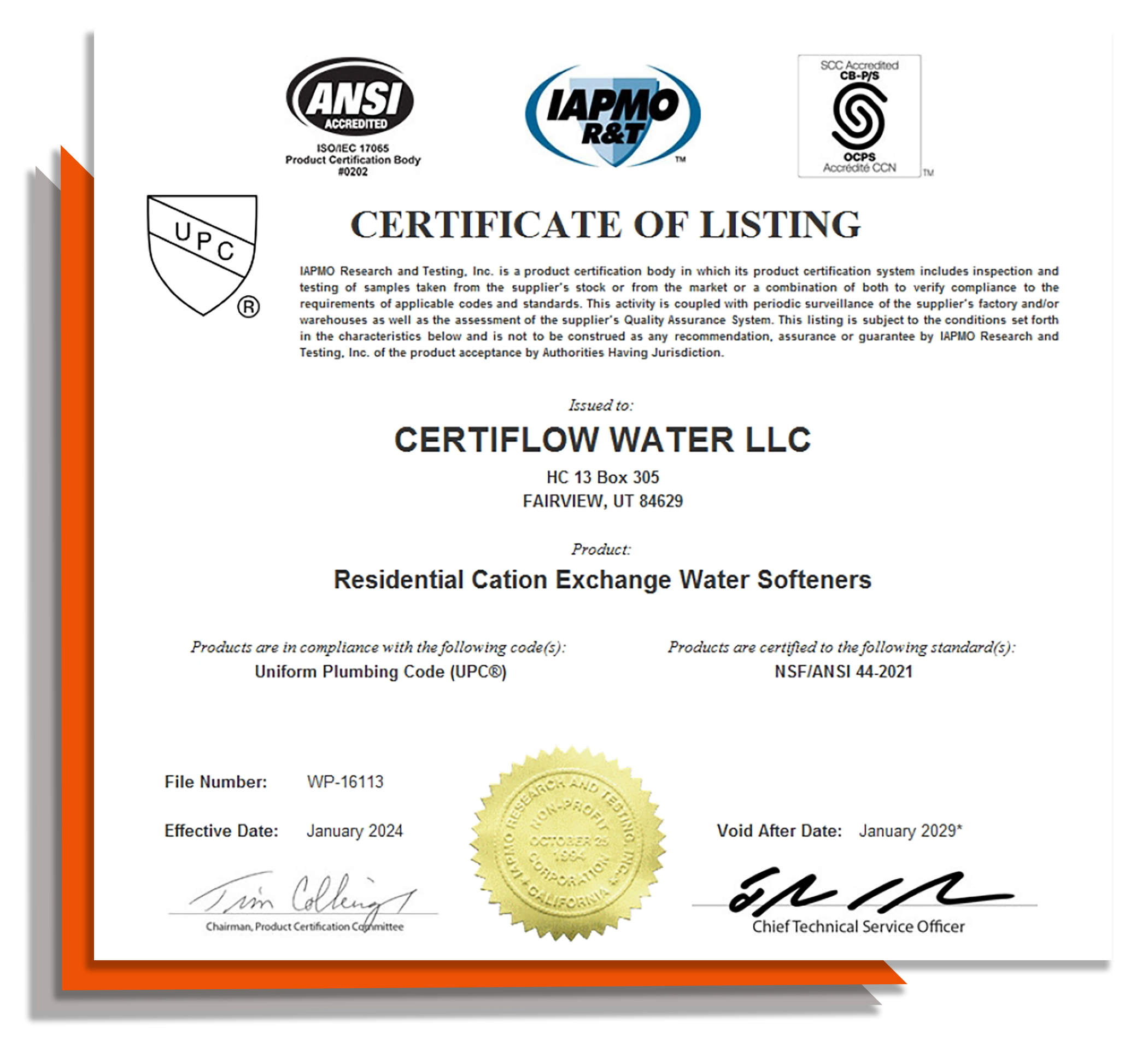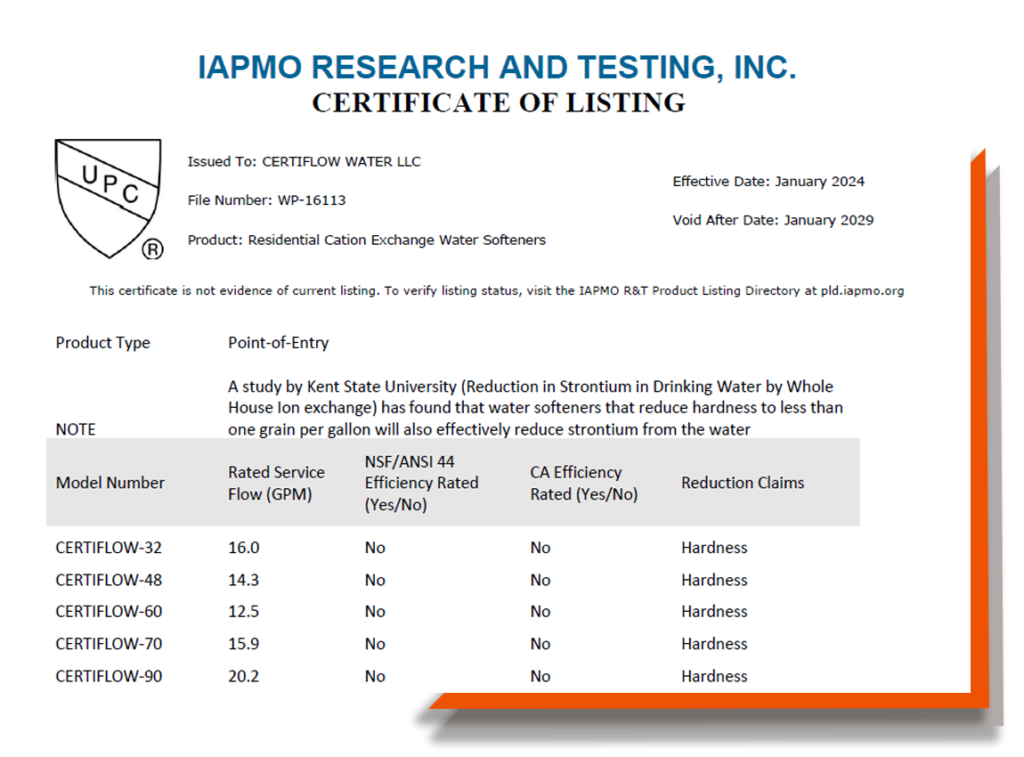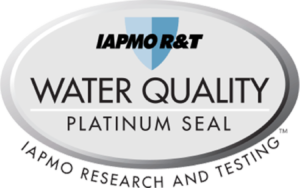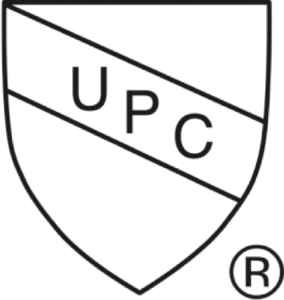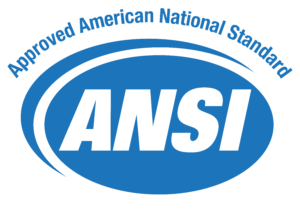Certiflow Water Treatment systems
Water filtration for your home and business
- Residential and Commercial Water Softeners
- Whole House Filtration Systems
- Iron and Sulfur Removal Systems
- Reverse Osmosis Systems
- Lifetime Guarantee

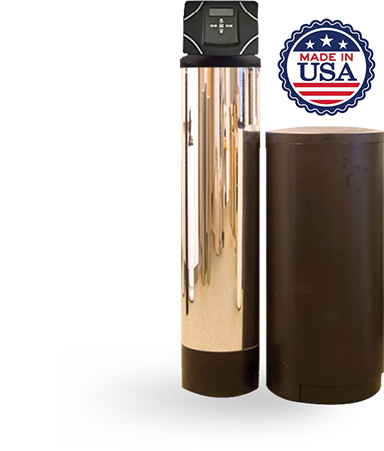

Utilizing The Most Advanced Water Filtration systems on the Planet. Our New Proprietary Certiflow Vision Valve by Clack. All Made in America
Once installing a water softener from Certiflow, your household or business will begin to notice the improvements in water quality quite soon. The water running through your plumbing is now soft and at its best quality for use. The advantages of water softeners and their effects on drinking water are numerous, beginning with the fact that Hard water contains minerals such as calcium and magnesium, which dry and leave unsightly white streaks on your glasses and utensils. When you wash your dishes in Certiflow’s water softeners, you will receive a gleaming, streak-free finish.
Read More
Do you feel like your hair or skin is getting damaged day by day? It turns out that the type of soap you use, the moisturizer you use, or a genetic predisposition to dry skin might not be the cause of your dry skin. One of the advantages of Certiflow water softener is that the minerals are removed, making the water gentler on your skin and your hair. Many people prefer soft water over hard water because it doesn’t taste like minerals, fluoride, chloramine, or any other additives, natural or chemical. Our service is just what these individuals require.
- With the new Clack Vision valve, you are getting the newest in softener technology with Progressive Flow Technology.
- With available full port flow sizing from 1in, 1.25 in, 1.50 in , 2” , & 3in. With the full port flow sizes, the Clack Vision Valve meets all Plumbing Codes flow rate requirements.
- All Certiflow systems have included the new progressive flow that allows us to connect multiple units in both progressive and alternating systems and allows for future expansion.
- The Certiflow water system with the Clack Vision valve has a Pre-Brine, Up-flow, proportionate brine, self-cleaning technology, and maintenance-free system that saves you 25% water and uses less salt.
- The Certiflow water softener has the highest chlorine resident & longest lasting resin on the market.


What Makes Certiflow Different?
Certiflow is not just the company name. It is a requirement by every plumbing code in the country. Certiflow started its initial introduction in 1986 by a Plumbing Code instructor and Master Plumber. He found in the Plumbing code that all water treatment systems must be certified and must meet the flow rate and pressure loss for the home requirements. He created the first water softener in the country to meet the plumbing code.
Size your water softeners according to the plumbing code and you will have the correct size equipment for your home.
The majority of companies in the water treatment industry, sizes water softeners incorrectly!
Number of people in the family? Etc.
A water softener should be sized according to how much media do I need to soften the water if I run my faucets at full flow or several fixtures at a time?
How much media do I need to soften a ¾”, 1” or 1.25” Main water line? What does number of people have to do with any of this?

*All products manufactured to meet or exceed NSF44 Standards
How to Size a Water Softener Correctly for your Home
First you must find the Flow Rate requirement demand for your home
In the Plumbing code Water line sizing is done with the use of Fixture Units.
Each plumbing fixture is given a water flow value.
Water Softener Quick Sizing Guide

Table 2 - Typical Fixture Counts
House Size | Fixture Units | Flow Rate | Meter Size | Water Line Size |
|---|---|---|---|---|
1 Bath | 7.8 | 12.8 | 3/4″ | 3/4″ |
2 Bath | 11.4 | 15.4 | 3/4″ | 1″ |
2 1/2 Bath | 14.3 | 17.0 | 3/4″ | 1″ |
3 Bath | 15.0 | 17.5 | 1″ | 1″ |
3 1/2 Bath | 17.3 | 18.4 | 1″ | 1″ |
4 Bath | 18.6 | 19.0 | 1″ | 1″ |
4 1/2 Bath | 20.9 | 19.7 | 1″ | 1″ |
5 Bath | 22.2 | 21.5 | 1″ | 1″ |
This chart is based on International
Plumbing Code 2018-2021.
Reference: Table (E103.3)
Reference: Plumbing Code Requirements and Sizing Guide for Residential Water Softeners, Second Edition
Table 2 was created by (Marlin Mechanical), as an aid and quick reference to common fixture counts. Actual fixture counts may vary.
Criteria used for creating chart:
- Water Line sizing was done with 50 to 60 PSI with a developed length of 40 to 50 feet.
- Single Laundry
- Single Kitchen sink with dishwasher
- 3 fixtures per bath
- Hose bibs not used in fixture water load.
*Softeners used exclusively for laundry are not required to be certified
Certiflow Water Softener System Sizes
Certiflow Water Softener System will meet the plumbing code for all home sizes

Size your Softeners by the Size of the Main Water Line in your home
Main Water Line | Softener Size |
|---|---|
3/4″ Pipe | 48,000 |
1″ low flow | 60,000 |
1″ Pipe | 70,000 |
1.25″ Pipe | 90,000 |
Certiflow Water Softener System Sizes

48,000 Grain | |
|---|---|
Water Pressure | Flow Rate |
35 psi | 14.3 |
45 psi | 15.2 |
55 psi | 16.4 |
65 psi | 17.6 |

70,000 Grain | |
|---|---|
Water Pressure | Flow Rate |
35 psi | 15.9 |
45 psi | 17.1 |
55 psi | 19.4 |
65 psi | 21.5 |

90,000 Grain | |
|---|---|
Water Pressure | Flow Rate |
35 psi | 20.2 |
45 psi | 24.4 |
55 psi | 28.7 |
65 psi | 32.4 |
Get Rid of Hard Water Problems
The Restriction And Reduction Of Flow Rate And Pressure Loss Is The Reason Most Water Softeners Do Not Meet Plumbing Code
-
The First and Foremost Requirement is Certification (303.1 – 303.4).
All Water Softeners Must Be NSF 44 Certified*
- Chapter 6 and E103.3, Part 3, Item 3.5 Require all equipment to meet the Flow Rate and Pressure Loss Demand for the Application.
- Without Certification, it is NOT POSSIBLE to determine if the equipment has the proper engineered sizing to meet the requirements of the intended application.

The Restriction and Reduction of Flow Rate and Pressure Loss is the Reason Most Water Softeners Do Not Meet Plumbing Code

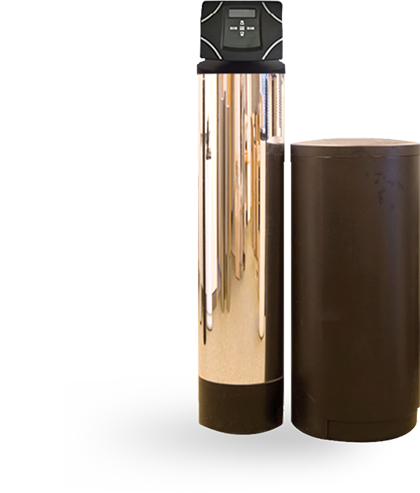


The water flow through most softeners are restricted on purpose.
Many people who have softeners sized incorrectly will complain that they do not always have constant soft water. Even with the restrictions, it is possible to run the water faster than you can soften it.
It is estimated that 80% of all water softeners sold are 1-cubic foot water softeners
In other words
"30,000 grains"
This amount of resin will only soften the water at a maximmum flow rate of 8 gpm.
The water softener valve manufacturers purposely restricting the flow so the water does not run through the equipment faster than that amount of resin can soften it.
Fresh water for your home and business
What is a water softener and its function
A standard water-softening system substitutes calcium and magnesium ions in hard water with sodium Bicarbonate ions. (Baking Soda) Calcium and magnesium ions, but not sodium Bicarbonate, interfere with the action of home soaps and detergents. As a result, the water-softening process aids detergents in more successfully removing dirt and oils from clothing and dishes. It also helps soaps protect your skin from feeling “oily” while you’re washing it. Most water softener manufacturers recommend reducing the quantity of soap and detergent you use after installing a water softener.
A certiflow water softener unit is installed in your home’s plumbing near the point where water enters the house, softening the water used for drinking and washing but not for irrigation. Several cubic feet of porous plastic resin is covered with molecules that attract and bind to positive ions dissolved in water in the unit.
This causes sodium Bicarbonate (Baking Soda) ions to be released into the water to keep the resin’s electrical charge balanced. Most sodium Bicarbonate ions are gradually released into the household water, and the resin gets saturated with calcium and magnesium ions. The resin must be renewed when the exchaThe Chloride, calcium and magnesium ions and the salty rinse water are flushed down the drain, and the system returns to regular operation. To prepare this salted rinse water, a bag of sodium chloride salt must be added to the softener unit Every few months.
Read MoreImagine what soft water can do for your clothes if it can do so much for your skin and hair. Certiflow water softener will assist you in achieving healthy hair, healthy drinking water, and drainage systems that are free of clogs. To summarize, it will assist you in resolving any water-related issues while also improving your living standard through our superior products and services.nge sites become saturated. by rinsing it with a concentrated salt water solution (sodium chloride), Only the Sodium Bicarbonate portion of the salt is used in the cleaning. The Chloride has no purpose and will be flushed from the system during the cleaning process. generally, in the middle of the night.
The mineral Tank
By eliminating calcium and magnesium from the water, the problem of hard water can be remedied. A water softener is the most ideal option.
A water softener is a mechanical device that is connected to your home’s water supply system. All water softeners work on the same principle: they exchange minerals for something else, usually sodium Bicarbonate. The procedure is known as ion exchange.
A water softener’s mineral tank is its heart. Tiny polystyrene beads, sometimes known as resin are used to fill it. The beads are negatively charged.
Water softeners feature a separate brine tank that uses common salt to make brine solution. Positive quantities of sodium ions exist as well, although not as strongly as calcium and magnesium. The sheer number of sodium ions in this tank is enough to drive calcium and magnesium off the beads when a liquid is forced through it. Hard water flows into the mineral tank in a typical operation, where calcium and magnesium ions replace sodium ions. In water, sodium ions dissolve. During the recharge phase, sodium-rich salt solution is transferred from the brine tank to the mineral tank. The Certiflow unit initiates a three-phase regenerative cycle once the beads have been saturated with calcium and magnesium and then backwashing starts by reversing the water flow to flush dirt out of the tank.
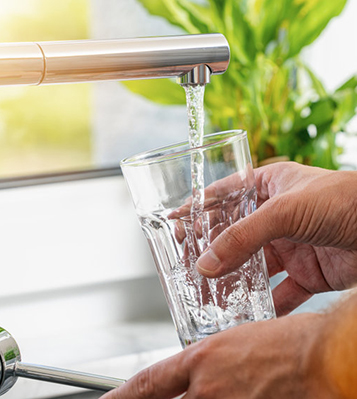
The Brine Tank
The brine tank is just what it sounds like: a plastic tank filled with brine, salty or potassium-saturated water. Backwashing the mineral tank with this salty water removes mineral particles and restores the beads’ negative charge, allowing them to collect more minerals.
The sheer number of sodium ions is enough to drive the calcium and magnesium ions off the beads when a solid brine solution is forced through a tank holding calcium and magnesium-saturated beads. Water softeners have a separate brine tank that produces most brine solution using ordinary salt.
In basic functioning, hard water goes into the mineral tank, where calcium and magnesium ions replace sodium Bicarbonate ions. The sodium Bicarbonate ions dissolve in water. The water softener unit initiates a three-phase regenerative cycle once the beads have been saturated with calcium and magnesium. The backwash step begins by reversing water flow to flush dirt from the tank.
Certiflow water softener systems use a unique Pre-brine feature That will create the brine solution three hours before cleaning. Eliminating standing water in the brine tank and reducing the chance of harmful bacteria build up experienced in most other manufactures water softeners.
Certiflow Optional Proportional Brining
When proportional brining occurs, the volume of water transferred to the brine tank when regeneration occurs is “proportional” to the softener’s remaining capacity. This means that the amount of salt used will depend on how much power is left in the unit. In theory, just the media that has been depleted gets regenerated. Except for twin units, every softener must regenerate before using 100 percent of its capacity; otherwise, the household will suffer hard water.
Proportional brining is a mechanism built into controllers that will only fill the brine tank with enough water to dissolve the amount of salt needed to regenerate the capacity that has been utilized. Proportional brining is achieved by comparing the softening power utilized to the overall capacity of the device. The controller then changes the brine fill time (which regulates salt usage) based on the actual ability. Using proportional brining, the device will fill the brine tank with only the amount of water required to dissolve the salt necessary to equal the capacity utilization. Only units that can regenerate in an up-flow mode, which means the brine flows from the distributor into the gravel and up through the media, are eligible for proportional brining.
Proportional regeneration applies the same idea to the cycle periods of the regeneration process as proportional bringing. If the entire capacity of the system is not used, Ceriflow proportional brining minimizes the cycle times of the regeneration sequence, which saves water. This proportional regeneration option may be used on softeners and filters to save water and money during regeneration cycles.
The proportionate regeneration feature will automatically modify the regeneration sequence’s Backwash and rinse timings, saving 14 percent of the gallons needed in the regeneration process. The brine and brine rinse cycles are unaffected by proportional regeneration.
Another distinguishing aspect of water-proportional right’s bringing, and proportional regeneration features is the option to customize the proportional regeneration parameters. Both high and low parameters are established by the manufacturer, but they can be changed in the field by percentages; the existing system can regenerate with as little as 10% of the original manufacturer settings or as much as 150 percent.
The regeneration process is the most technical aspect of a water softener. Once the resin has caught all hardness minerals, the system must be cleaned using a saltwater solution (brine).
The regeneration process entails flushing the water softener for 10 minutes with the Block Sodium Bicarbonate /salt that has been loaded into the unit. Then a back wash for 8 minutes and a final, 4 minute fast rinse cycle rinse cycle from the top to pack the media bed. These processes will ensure that softened water is continuously delivered to your home.
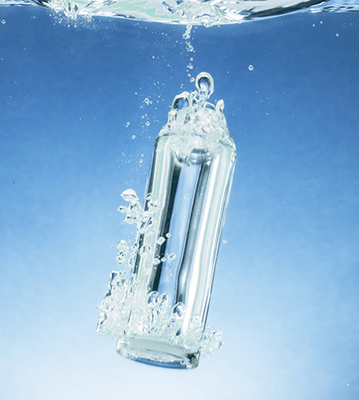
Certiflow Control Systems
The Certiflow Control systems all utilize a Clack control valves for water treatment professionals that covers the widest range of applications while maintaining the highest level of component commonality.
Clack released its first range of home control valves in 2001, following years of development and rigorous field testing.
The WS1 series valves were the first valves designed with the world’s water treatment professionals in mind and incorporate many features that directly result from customer feedback. The WS1 valves are manufactured from composite plastics and are designed to provide high flow rates (up to 27 GPM) over a wide range of applications.
The next generation of Clack controls were launched in 2020. The Certiflow Vision valve is designed using proven mechanical technology, coupled with the latest advancements in computer tech. Clack valves incorporate patented “stack technology.” Creating a valve that will last for may years without needing maintenance or service and can be rebuilt in one simple change of a universal “stack” cartridge.
Read More
What is the flow rate required for your home and main water line size?
Size | Fixture Units | Meter | Flow Rate (GPM) | Main Water Line |
|---|---|---|---|---|
1 Bath | 7.8 | 12.8 | 3/4″ | 3/4″ |
2 Bath | 11.4 | 15.4 | 3/4″ | 1″ |
2 1/2 Bath | 14.3 | 17.0 | 3/4″ | 1″ |
3 Bath | 15.0 | 17.5 | 1″ | 1″ |
3 1/2 Bath | 17.3 | 18.4 | 1″ | 1″ |
4 Bath | 18.6 | 19.0 | 1″ | 1″ |
4 1/2 Bath | 20.9 | 19.7 | 1″ | 1″ |
5 Bath | 22.2 | 21.5 | 1″ | 1″ |
Anyone Sizing A Water Softener According To The Number Of People In The Home Has No Concept Of Plumbing Or The Plumbing Code
Water that is safe, clean and soft
Certiflow Water softener

Certiflow Water Softeners are the best in the industry when it comes to providing families and businesses with high quality soft water.
Certiflow provides clean drinking systems and water purification systems by providing equipment while having a nationwide relationship with plumbers that offers their products to make your life easy and healthy.
Hard water is one of the world’s biggest problems and it is believed that the issue influences a lot of home appliances. The best opportunity to manage hard water is before it starts causing problems. To avoid limescale from harming your lines, staining your fixtures and fittings, and extending the life expectancy of your machines, you should change your hard water to soft water.
Certiflow water softeners are filtration equipment that eliminates high calcium and magnesium fixations that produce hard water. When water goes through a Certiflow Water Softener, it channels away the hard water minerals, and leaves the soft water to move through funneling. The positively charged calcium and magnesium ions are attracted to the resin bed as water runs through Certiflow Water Softening System. They adhere to the resin while positively charged sodium ions are discharged into the water, replacing the calcium and magnesium with sodium.
Certiflow water softener is a house filtering system that utilizes molecule exchange to dispose hardness and handles one of the most widely recognized and damaging water issues: hard water. Due to hard water, scale gathers in your lines, hindering them and lessening water pressure. Scale altogether decreases the lifespan of appliances like dishwashers, espresso creators, and ice machines. High-temperature water apparatuses are annihilated by hard water. The more calcium and magnesium solidify into vital stores inside your heated water storage, the more prominent the temperature of the water.
Read More
Certiflow uses different equipment as well as plumbers around the nation to help you make your water soft. All Certiflow Equipment has Progressive Flow and Alternating option.
Stop Wasting Money Down The Drain! A Water Softener Pays For Itself!
Hard water and problems caused by it
Where Problem Begins
You’re probably wondering how hard water develops or how the problem arises. Water is a good solvent that rapidly takes up contaminants. Pure water is sometimes referred to as the universal solvent because it has no taste, colour, or odour.
When water and carbon dioxide are mixed to make very weak carbonic acid, an even better solvent is produced. Water dissolves relatively minute amounts of minerals and holds them in solution as it flows through soil and rock.
Read More
Water hardness is commonly seen in mg/l as CaCO3 equivalent, but other techniques indicate the degree of hardness. In general, soft water contains less than 60mg/l Ca CO3 equivalents, and hard water includes more than 120mg/L Ca CO 3 equivalents. The majority of tap water comes from local sources, although some towns may draw water from several – and occasionally even remote – places as needed. As a result, depending on the particular source site and time of year, water hardness or softness changes might occur within the same town. Hardness in your home’s water is caused by minerals, specifically calcium and magnesium. We usually think of minerals as nutrients that help us stay healthy. However, if your water has too much electrolytes, it can be harmful. The minerals in most drinking water are dissolved rock, which is difficult for the body to absorb.
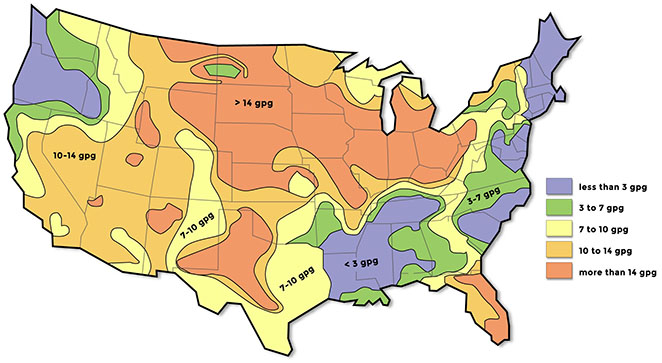
The degree of hardness must be perceived from your appliances’ point-of-view the problems with appliances start at minimal hardness levels. Some locations in the United States exceed 50 gpg. Obviously appliances wear out much faster at those levels, but remember that “extreme wear” occurs on any appliance employing water in excess of 3.5 gpg.
Conditioned Water | <1 gpg |
|---|---|
Moderately Hard | 1-3.5 gpg |
Hard | 3.5-7 gpg |
Very Hard | 7-10.5 gpg |
Extremely Hard | > 10.5 gpg |
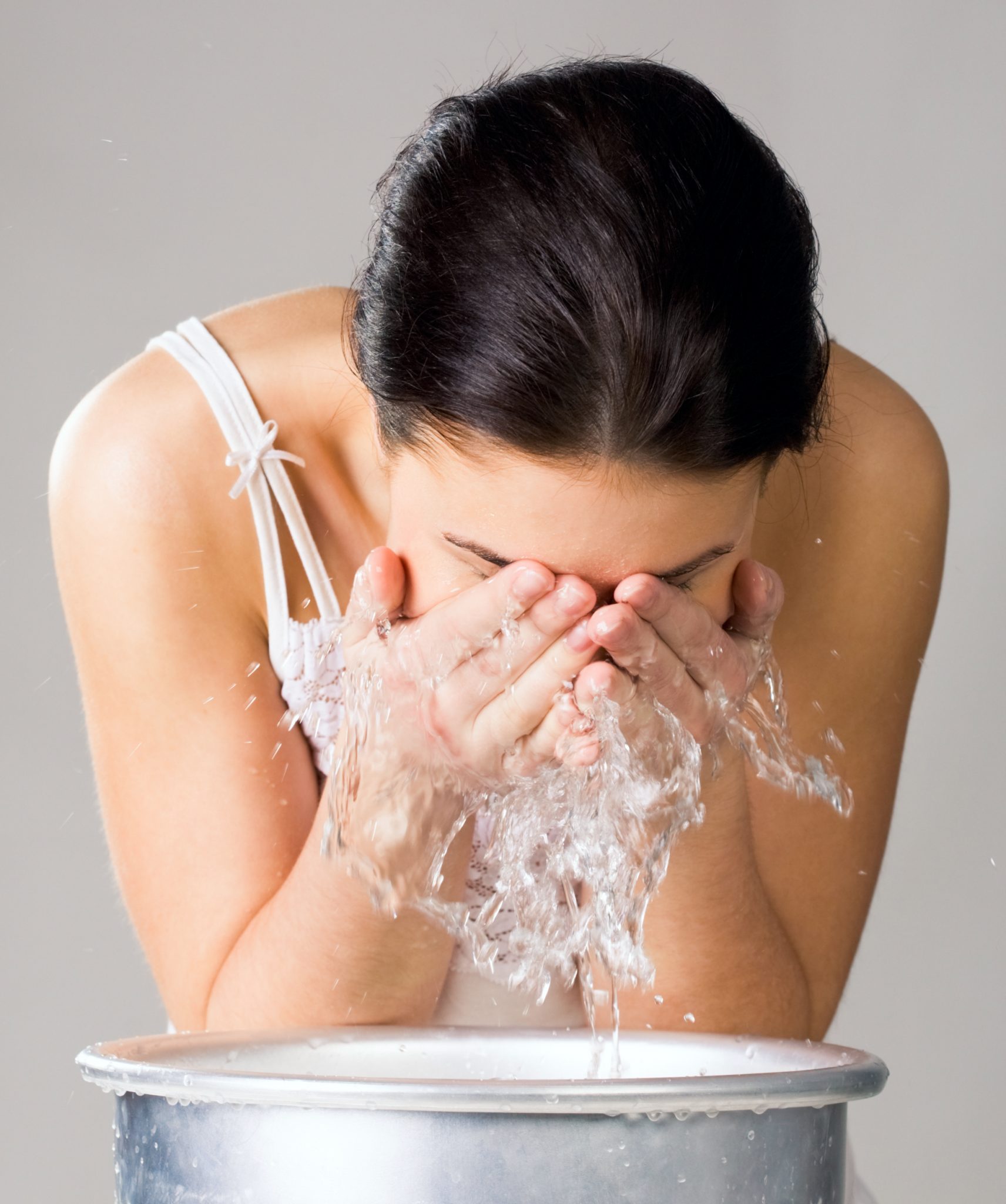
The Benefits of Soft Water On your Plumbing
- Flow Rates: flow rates remain at peak flow; no clogging
- No Scale: maintain high efficiency of water heaters, dish- washer and laundry diaphragms do not corrode, toilets and sinks do not experience "hardness-block"
- Laundry Machine: eliminates hard-water issues-extending appliance life by 75% according to a study by the American Water Works Association (AWWA)
- Laundry: 50% to 75% less detergent
- Clothes: cleaner, brighter;
- Extends clothing life by 15%; no skin-irritating chemicals left over in fabrics.
Frequently Asked Questions
Water naturally evaporates from oceans, lakes, and rivers to form clouds. Pure water then falls to the earth as rain, snow, and sleet cleaning the air, and picking up contaminants on the way down. This water, which falls back to the earth, becomes more aggressive. As moisture hits the earth and filters through layers of rock and dirt, it picks up minerals like calcium and magnesium which concentrate the hardness of the water.

Hardness can cause a variety of aesthetic challenges for homeowners. Hard water creates a mineral buildup on water-using appliances such as water heaters, dishwashers, and laundry machines. This mineral scale decreases efficiency and causes premature ware on the appliances. In addition, because hard water contains contaminants that interfere with cleaning, homeowners find themselves using more soap and chemicals to clean. To avoid these problems, homeowners often invest in a water softening unit to remove the hardness from the water.
Basically water hardness is measured by the amount of hardness minerals (generally calcium and magnesium) in your water. These amounts are measured in grains per gallon (GPG). The following table illustrates the hardness magnitude of water:

Often people say, “I’ve heard of places that are 30 grains hard, or even 60 grains hard. This scale cannot possibly be all encompassing!” The United States has some areas that exceed 100 gpg in hardness, but this scale is based on appliance tolerance to hard water. Take your dishwasher for example: The softer the water, the longer it will last. Under moderately hard water, your dishwasher will last several years–even though it’s not entirely soft water. On the other hand, if you’re on extremely hard water, your dishwasher may only last a few years before hard water completely incapacitates the appliance. Certainly the dishwasher will run on 50 gpg hardness, but its lifespan will be dramatically shortened.
While you don’t necessarily have to use salt, every water softener uses a cleaning agent of some kind–most use salt.
A water softener can only “absorb” so many hardness ions; and after it has reached hardness saturation, it must regenerate (trade all the hard ions for soft ones to be able to soften more water). When the softener regenerates, it must use a solution of some kind to rinse away the hardness ions. Most commonly the solution is sodium saturated water (salt water). Alternatively a potassium solution can also be used to regenerate the resin.
Perhaps you’ve heard of magnetic water treatment systems or catalytic converters. Marketers of these water treatment devices are very careful regarding what they say. Truly magnetic systems can change the chemical balance of the water and suspend hardness ions in the water.
However, most neglect to mention is that even though the hardness ions have been suspended, they’re not removed from the water. If the hardness ions are not kept in the heavy magnetic field, the hardness ions resume their “hard” effect on the water. Magnetic water treatment units were developed by the U.S. Army as a cost effective way to eliminate the effects of hard water while the water travels through boilers (or other in-line water equipment)–and magnetic water treatment systems do exactly that: while the water’s in the boiler it’s soft, when it comes out again, it’s already rebalancing its chemical composition and becoming hard again.
To maintain the effect of magnetic water treatment system, you would have to install strong magnetic polarity devices every few feet on your household pipes. Otherwise, the water passes through, becomes soft then “hardens” again in your pipes.
If you’re not used to soft water, it’s not uncommon to leap into a shower and lather up and suddenly feel slimy, silky, or very slick. That slimy feeling comes from the glycerin in soap itself. Soft water is exponentially more effective than hard water for dissolving substances. When you’re used to using a certain amount of soap in a hard water shower, when you use the same amount of soap in soft water, you’ll be swimming in suds. You’re using the same amount of soap, but now that soap is up to 50-75 percent more effective.
Soft water is safe to drink for virtually everyone.
If you participate in a very strict sodium-restricting diet, salt-softened water may not be right for you. To give you an idea how the additional salt affects your sodium intake, consider this: an average soft-water consumer takes in about five grams of sodium through normal eating and drinking. Of those five grams of sodium, one-third of one gram (0.336 g) is from softened water the equivalent weight of half a watermelon seed. A black olive contains 238 times the amount of sodium you’ll consume in an entire day from soft water! That’s how little sodium is added to your diet through soft water.
Some people mistakenly believe that soft water is salt water. Basically when you soften water it runs through resin beads to remove hardness. When the resin beads can’t remove any more hardness, you have to regenerate the resin with a salt solution. Only when the resin is regenerated does water flow through the softener as product water–flowing over beads that have been rinsed with a salt solution. Sodium is contributed to the soft water in trace amounts, but is generally not a cause for concern in most consumers’ diets.
Soft water cleans much more effectively than hard water. To accomplish the same results, soft water requires 50-75 percent less soap or detergent than hard water. This alone creates a great cost savings over time. When you first start using soft water take special care to quarter the amount of soap you typically use. For a lightly soiled load of laundry in a laundry machine, a heaped teaspoon of powdered detergent should be sufficient. You don’t need to fill your dishwasher detergent bin to heaping–in fact only fill it a quarter of what you used to. While the 1/4 rule is generally sound, experience is the best teacher in this area.
First soft water is not a cure-all for dry skin and eczema. That said, dry or itchy skin is often caused by foreign substances on the skin, substances that can be greatly reduced if not eliminated with soft water. Many sufferers of dry skin or eczema report improvement after using soft water. Because so many factors influence the skin, it’s impossible to quantify the effects of soft water on the skin.
However, many benefits are unchallenged: soft water requires less soap or detergent and rinses cleaner than hard water, soap curds and other chemicals are rinsed away leaving pores naturally open–allowing the skin to “breathe.” With clearer skin, and less chemicals to irritate the skin, dry skin sufferers and eczema patients generally experience softer, healthier skin with continued use of soft water.
Under normal conditions, resin (the tiny beads that facilitate the ion-exchange process) should last approximately 20 to 25 years. Resin life can be reduced, however, under harsh water conditions like severe hardness, the presence of excessive iron in the water, or abnormal pH extremes.
Your water softening system should be disinfected after installation. The softener should also be disinfected periodically throughout the life of the softener, or as indicated by a plumbing professional according to local water conditions.
The salt tank should be cleaned at least biennially, depending on the grade of salt you’re using (Higher grades of salt require less cleaning as it is purer). Cleaning the salt tank every two years ensures your softener will avoid problems associated with salt “mushing” or “gumming.” Simply remove the salt and clean out the salt tank and the float assembly with water.
Some salt may become encrusted on the bottom of the tank–this is normal salt crystallization, but it should be removed to ensure proper regeneration. Do not use chemicals in the tank unless the chemicals are approved water softener treatment chemicals–any resident chemicals potentially enter the water supply.
Yes you can. While many plumbing fixtures become part of the home, many people choose to take their water softening system with them when they move. You’ll have to place the system in bypass (which allows hard water to flow through the valve independent of the softener), then disconnect the system.
You are also the original purchaser so your warranty will still be in force. Alternatively, some people elect to leave the softening system in the home and sell it with the home and purchase a new one when they arrive at their new home.
A properly sized water softener uses an efficient amount of water for each regeneration, based on household water pressure (PSI). Keep in mind that a typical five-minute shower uses between 25 and 50 gallons of water according to the EPA. Oceanus systems have the following regeneration water usage:

Occasionally a customer will undersize a system to take advantage of lower regeneration water usage, without taking into account the time between regenerations. This is actually less efficient. For example, if a 70 grain system is installed in the place of a 90 grain system, each regeneration uses 15 gallons less water. However, regeneration occurs nearly twice as often.
For this example, in a four-week period the 70 grain system regenerated nine times, using a total of 405 gallons of water. The 90 grain system regenerated four times for a total of 240 gallons. Clearly a properly sized unit is more efficient (almost 2:1 in this example) in the long run based on gallons of water used.
The inverse is not a good idea either. Over sizing a system to take advantage of the most efficient water usage allows too much time to pass between regeneration cycles. This allows naturally occurring bacteria to grow in the system and creates a sanitization problem inside the water softener.
Salt blocks can cause disproportion in the brine solution, and may cause a water softening unit to regenerate inefficiently. We recommend using a cube, pellet, or granular type of salt. These types supply a better brine solution that ultimately contributes to the overall efficiency and effectiveness of your unit.
Remember that both hard and soft water have minerals that will ultimately be deposited in the soil. Most plants don’t take to soft water, as sodium is more difficult for a plant to deal with than magnesium and calcium (the hardness ions). Rain, distilled, or deionized water is the healthiest for plants because they generally do not contain elements that are difficult for plants to use.
We recommend leaving your outside hose bibbs tapped to the hard water line as watering your garden with soft water is both wasteful and more difficult for plant survival. On the other hand, other applications such as car washing persuade some consumers to turn one hose bibb soft and leave the other hard.
Due to the aggressive nature of pure water, manufacturers of reverse-osmosis systems recommend that all tubing associated with high-purity water (RO water fits this category) should not be metal.
When water flows down a stream it gradually gathers particles and moves them downstream–producing erosion. As a matter of physics; the higher the purity (concentration) of water, the more aggressive water is. The more aggressive water is, the quicker it erodes materials. Metal particles very gradually shave off in RO water, which is why plastic (which will not shave off) is recommended. If you use metal piping such as copper, you will likely be paying for water damage to your home (due to a leak) within ten years.
Chapter 6 of the 2001 California plumbing code (UPC) allows for piping changes in aggressive water situations
At any time outside of regeneration completion, the unit is designed to hold 12 to 18 inches of water with the salt in the brine tank. This amount of water maintains the proper salt saturation in the water (brine). Immediately after regeneration, the salt tank will still maintain 2 to 3 inches of brine. This is to ensure the softener does not suck in air if there is any time left in the regeneration.
No, power outages will not damage the softener in anyway. The valve head has non-volatile memory to remember your water usage patterns even if the power goes out. The clock is digital and will be affected by power outages lasting longer than one hour, so you will need to reset the time on the controller. All other settings will remain as unchanged.
Yes you can install a softener outdoors. Be aware however, that while brine will not freeze, water inside your softener will. Water that freezes inside a water softener can crack resin beads and even the softener tank–obviously rendering the unit less efficient and potentially destroying the unit. Do not allow the unit to freeze. Some customers elect to keep the unit inside and then run piping from the unit to the brine tank outside. This can conserve some space inside while still ensuring your unit will not freeze. An outside brine tank also allows for easier salt loading.
If you live in a climate that does not reach freezing temperatures, the unit can remain outside indefinitely. In order to avoid sun damage, try to keep the unit out of the weather and out of direct sunlight. A simple enclosure generally remedies the problem.
The softening system is guaranteed for life to the original purchaser of the equipment. The valve, mineral container, resin, and salt tank are all covered under the lifetime warranty. Workmanship and materials are guaranteed for five years at the original installation site. After five years anything that fails on the system will be repaired for a maximum charge of $75.00 plus shipping (labor not included).
Make sure you register your warranty to validate it!
Keep in mind that the unit must be installed properly to validate the warranty. That means the softening system must be installed as follows:

Most freshwater fish acclimatize to soft water without incident. Remember however, that a fish’s world is entirely composed of water. Minute changes in pH, temperature, or salinity can result in aquatic fatalities. The best course of action to expose fish to softened water is to gradually replace the water in the tank over approximately one month. Replace approximately 25 percent of the tank every week. In this way fish will gradually become familiar with the new medium in which they live. At the end of one month replace the entire water volume with clean, fresh softened water.
Reverse osmosis water is comparable to soft water for its benefits, but flow restrictions generally bar it from household use except for drinking water. However, for a standing application like a fish tank, reverse osmosis high-purity water is the best solution. Softened water runs a close second.
Steam irons operate best using water devoid of minerals. Soft water removes calcium and magnesium, but leaves other minerals suspended in the water. In most applications these minerals do not present a problem, which is why soft water is nearly always a superior choice for water. Because steam irons evaporate water rapidly, you will develop encrusted mineral deposits if you use any water grade other than distilled water.
Because soft water is so effective at maximizing the efficiency of your water, you will not have to use nearly as much detergent or soap as you would with hard water. Using soft water allows you to save 50-75 percent of your detergents and soaps; or to put it another way, you can go 50-75 percent longer without purchasing detergent or soap again. A bar of soap that lasts for three weeks in hard water will last longer than five weeks. If your laundry detergent lasts you for two months, you’ll be able to go three and a half months before purchasing again.
Also soft water saves you time as you clean. If it takes you thirty minutes to clean your bathroom or kitchen, it will take less time because soft water cleans better than hard water, and leaves little to no mess (in the form of water spots) in the first place! If you were going to pay some one to clean your home, how much would you pay them? That’s how much you’re saving by doing it yourself–and simplifying.
Your water heater and other water using appliances (dishwasher, laundry machine) will last longer in general and will not require as much maintenance. You will also see improved performance (or maintained performance) in your water heater because scale caused by hard water decreases heating efficiency exponentially over time. Because soft water prevents that scale, you’ll maintain efficient heating–saving you money on your energy bills.
Your plumbing will also see the benefits of soft water. All your fixtures and pipes will last longer (extremely hard water can clog a faucet or toilet in as little as five years!). Hard water scale builds up in your pipes and decreases flow rates; so with soft water, you’ll maintain your high flow rates.
Most softeners pay for themselves after five to seven years depending on a range of variables including original price, cost of living in your area, household size, water hardness, and frequency of cleaning. Think of a water softener as an investment. How many investment strategies pay themselves out in five years? Not many.
Waranty information
All you need to know about the warranty
*Warranty applies to Manufacturing defects only, to the original owner at original installation site*
Lifetime Warranty Items:
- Mineral Tank, Brine Tank Shell and Control Valve Body all carry a Lifetime Warranty against manufacture defects only.
- *Service, Labor and Freight Charges Not Included*
10-year Warranty Items:
- Cation Softening Resin carries a 10-year warranty on NON-chlorinated water only, against manufacture defects only.
- *Service, Labor and Freight Charges Not Included*
5-Year Warranty Items:
- All Digital and Mechanical parts carry a 5-Year warranty, against manufacture defects only.
- *Service, Labor and Freight Charges Not Included*
Certiflow Water will repair or replace defective part at manufactures option, provided that the part is returned to Certiflow Water, freight prepaid. All service must be performed by an authorized technician. *Service, Labor & Freight Charges are Not Included by Manufacture*
Maximum Replacement Charges (Per Item):
- Your Warranty provides for a MAXIMUM replacement charge PER item of $100.00 for any additional systems part not covered under the Lifetime Warranty section of the Warranty. Replacement charge is contingent to the below Warranty Exclusion section. All parts being replaced or repaired must be returned freight prepaid to Certiflow Water. *Service, Labor & Freight Charges are Not Included by Manufacture*
Warranty Exclusions:
- Defective warranty part or parts will be repaired or replaced at manufactures options, F.O.B. Certiflow Water, 19648 Lariat Circle Fairview , Utah 84629.
- All systems must be installed correctly by a licensed installer and meet all state and local plumbing codes.
- All service work must be performed by an Authorized Technician.
- This Warranty does NOT apply to and is VOID on all systems that have high chlorine and or chloramines levels in the raw water exceeding
1 PPM, or on systems that have been neglected, installed incorrectly, wrongfully applied, or if they have had hot water introduced through them from back-feed or incorrect installation, or have had any sand, silt, turbidity, organic loading or high Iron fouling, direct UV sunlight, freezing, fire, flood, power surges, brown outs, earthquakes, or any other natural disaster. This warranty does not apply and is VOID if systems have had vacuum or reverse flow. Protect systems from vacuum and reverse flow. - This Warranty does not apply on systems installed on waters of unknown quality. Do not install systems on waters that are microbiologically unsafe or of unknow water quality.
- This Warranty gives you specific legal rights. You may also have other additional legal rights which may vary from state to state by statutory provisions. Certiflow water will not be liable for any freight, labor charges, loss or damages caused by defective part.
certiflow water Refiner system
This is a system that works alongside a water softener. A water softener’s primary function is to remove minerals like calcium and magnesium from water and replace them with sodium ions, preventing scale build-up in plumbing pipes. On the other hand, a water refiner system removes contaminants such as chlorine, iron, and sediment in addition to the minerals that cause hard water. It also eliminates unpleasant tastes and odors from water. Water softeners work by passing the hard water entering a home through a tank filled with resin beads and brine.
This is where magnesium and calcium are converted into sodium. Ion exchange filters are used in Ceriflow water refining systems to remove other contaminants and toxins from the water. This system functions similarly to a water softening system, except that it exchanges hydrogen ions for any type of cation and hydroxyl ions for anions in the water. In this manner, in addition to magnesium and calcium, many chemicals are removed from the water. It’s a multi-use, clean water system.
A homeowner in need of fresh, pure water that is not only soft but also free of toxins should speak with a plumber who can examine the household’s demands and recommend the best type of water refiner for the home. Water refining is one method of treating water at home or in the office to ensure that everyone has clean, clear, and freshwater for drinking, cooking, cleaning, or bathing. Realizing why you should condition the water or how these systems work is crucial to getting the most out of the process and saving time, effort, and money. Pesticides, chemicals, toxic chemicals, iron, and lead are just a few of the impurities that can be removed with the help of Certiflow water refiner.
Understanding Carbon Media Life
Activated carbon is most likely one of the oldest filter media used in the filtration process. It has been used to purify water and remove harmful chemicals and odors since 400 BC.
Carbon, due to its versatility, can be used to purify various things, including air, drinking water, wastewater, food and beverages, and pharmaceuticals, according to our experts. Aside from its numerous applications, activated carbon is efficient and cost-effective. Activated carbon is unlike any other compounds in that it has the highest surface area per unit volume of any adsorbent known to man. Carbon is available in various forms, ranging from granular activated carbon to carbon blocks, and is made from a variety of materials. Activated carbon can be made from any material that contains enough carbon. Carbon can be produced from coconut shells, various grades of coal, or wood. Coconut shell carbons have a high percentage of small micropores, making them ideal for Volatile Organic Compound adsorption from groundwater streams.
Read More
- The carbon media MUST be replaced when saturated. (Full).
- Average life of the carbon filter medias will range between 2 years and 10 years. Life of carbon medias are all based off of the incoming chlorine/chloramine levels and water usage in gallons in the home.
- To figure out the life expectancy of the carbons, you must know what the raw chlorine/chloramine levels are in your water.
- The carbon media itself will give roughly: 1 million gallons of treated water- per cubic foot of carbon media @ 1 ppm of chlorine in the influent/incoming water.
- The Flow rate of 1 cubic foot of carbon for removal is 4 gallons per minute. Water flowing faster than 4 gallons per minute, though 1 cubic foot of carbon will be considered reduction.
- It is VERY important to properly maintain this carbon filter systems- and replace the carbon media on a set service schedule. The Certiflow Systems have the ability to set carbon life with service notice. Red Screen will flash when system reaches the desired amount of water.
To help you better understand daily your water usages, you can refer to the following estimated average water usage per person, per day:
- The national average of total water used per person- per day will range between 50 to 100 gallons per person- per day.
- That is an average of 18,250 to 36,500 gallons of water- per person- per year. Use the above averages, along with the incoming chlorine/chloramine levels, and size of carbon filter system to figure out the medias:
Coconut shell High activated carbon
Clack granular activated carbon is made from select grades of coconut shell coal to create a high density, long lasting fine grained product that can withstand the roughness and dynamics of repeated hydrodynamic transport, backwashing, and mechanical handling. It is designed to remove unpleasant tastes, odours, and dissolved organic chemicals from municipal and industrial water supplies.
Read More
To maximize the efficiency of activated carbon in the absorption process, the surface area should be as large as possible in the smallest practical volume. This is required because the rate of adsorption is proportional to the adsorbing media’s surface area. The surface area per gram of CS-HAC is 1,050 square meters. As a result, the system is becoming more efficient and cost-effective. It has been supplying activated carbon to the OEM and replacement markets for years as a pre-treatment for other water purification systems and for use in individual treatment equipment to remove specific impurities. The CS-HAC has an extremely high capacity, but it must be replaced when the filter bed loses its ability to reduce taste and odor. CS-HAC can be used in domestic or industrial applications, with either gravity flow or pressurized filter vessels. The capacity and efficiency are excellent due to the high surface area. A more efficient adsorption range is provided by a balanced pore structure.
Advantages
- CS-HAC is an outstanding material for applications requiring taste, odor, and dissolved organic chemical removal from water with suspended matter present. This product can be used for filtering waters having a wide range of pH levels.
- Large surface area results in an exceptionally high capacity and efficiency.
- A balanced pore structure gives a more efficient adsorption range.
- CS-HAC is very durable so losses due to attrition are kept to a minimum.
- CS-HAC has a very high carbon-low ash content.
- Service rates of 5 gprnisq. ft. are practical for ordinary taste, odor and chlorine loads.
PHYSICAL PROPERTIES
- Color: Blatt
- Mesh Size: 12 x 40
- Bulk Density: 28 lbs.ku. ft.
- Effective Size: 0.55-0.75 mm
- Ash Content: 25%
- Iodine Number: 1,000 mg/g
- Moisture as packed: 3%
- pH 10
CONDITIONS FOR OPERATION
- Water to be filtered should preferably be free of oil and suspended matter
- The water to be filtered should be relatively free of iron and turbidity for maximum service life
- Water pH range; wide range
- Bed depth: 26-30 in.
- Freeboard: 50% of bed depth (mine)
- Service flow rate: 5 gpm/sq. ft.
- Backwash flow rate; 10-12 gpm/sq. ft.
- Backwash bed expansion: 30-40% of bed depth
- Upon installation, backwash to remove carbon fines before )lacing unit into service
- Carbon is measured in Cubic Feet.
-
Correct Sizing of Carbon Systems:
1 cubic foot of carbon can remove 1 ppm of chlorine/ chloramines. -
Carbon Must Have Time to Absorb:
For removal of Chlorine/Chloramines: 1 cubic foot, can flow 4 gallons per minute. Any faster flow will be reduction. - Coconut Shell Carbon is used primarily for drinking water filters. It gives water a sweet taste.
-
Catalytic Coconut Shell Carbon:
Standard coconut shell carbon has a difficult time removing Chloramines. A catalyst must be added to change the

Catalytic High activated carbon
Catalytic carbon is activated carbon with a modified carbon surface. It is used to remove chloramines and hydrogen sulfide from drinking water. It possesses all of the adsorptive properties of traditional activated carbons and the ability to promote chemical reactions. This specially enhanced carbon was created through an advanced process that began with Granular Activated Carbon (GAC). It improves GAC’s catalytic capability by changing its electron structure, allowing it to cause chemical reactions without changing its form. As a result, it promotes a wide range of chemical reactions that are not possible with conventional carbons. Because catalytic carbons are not charged, you won’t have to worry about the charged carbons’ reduced organic odor capacity or higher bed fire potential.
Read More
Because catalytic carbon converts adsorbed H2S into water-soluble sulphuric acid and sulfurous acid, carbon systems can be regenerated with water washing to restore H2S capacity for less frequent physical change-outs. Catalytic activity promotes a wide range of chemical reactions; it is more effective than conventional carbons. A faster chemical reaction means less carbon and a smaller amount of equipment. There’s no need to be concerned about exothermic reactions, ignition temperatures, or toxic disposal with non-impregnated carbon. On-site regeneration reduces operating costs while also extending service life. Thermal reactivation allows it to be recycled and reused. Chloramines are used in distribution systems to control bacterial growth and reduce the formation of trihalomethane (THMs).
Advantages
- CAT-HAC is an outstanding coconut shell based material for applications requiring chloramine, hydrogen sulfide, and dissolved organic compound reduction. This product can be used for filtering water having a wide range of pH levels.
- Large surface area results in an exceptionally high capacity and efficiency.
- Balanced pore structure gives a more efficient adsorption range.
- CAT-HAC is very durable so losses due to attrition are kept to a minimum.
- CAT-HAC has a very high carbon, low ash content.
- CAT-HAC will impart a high “polish” to the filtered water.
PHYSICAL PROPERTIES
- Color Black
- Mesh Size: 12 x 40
- Bulk Density: 28 lbs./cu. ft.
- Effective Size: 0.55-0.75 mm
- Ash Content: Max 4°I
- Iodine Number: 1,000 mgig
- Moisture as packed: Max 5%
- pH 10
CONDITIONS FOR OPERATION
- Water to be filtered should preferably be free of oil and suspended matter
- The water to be filtered should be relatively free of turbidity for maximum service life
- Water pH range: wide range
- Bed depth; 2(-30 in.
- Freeboard: 50% of bed depth (min.)
- Empty bed contact time 3 minutes minimum
- Dissolved Oxygen Concentration 4 ppm (mg/L)
- Service flow rate: 5 gpmfsq. ft.
- Backwash flow rate: 8-10 gpm/sq. ft.
- Backwash bed expansion: 30-40% of bed depth
- Upon installation, backwash to remove carbon fines before placing unit into service
Cleaner water in 4 steps
What we recommend: Water Refiner 4
Four stage filtration system


Catalytic- High Activated Coconut Shell Carbon. Specifically designed for the reduction of: Chloramines, Hydrogen Sulfide and Dissolved Organic Compounds and their chlorinated by-products such as Chloroform and other Trihalomethanes(THMs), leaving a clean and fresh taste to the water.

High Capacity Coconut Shell Activated Carbon.
Used for reduction of:
Free Chlorine, Taste. Odor and Dissolved Organic Chemicals, leaving a clean and fresh taste to the water.

KDF-55 Media. Effective Chlorine and Heavy Metal reduction. KDF-55 Also inhibits the growth of bacteria.
Gravel Quartz Support Bed. Increases flow through filter system and helps protect distributor screen.
**REFINER Systems should not be installed on water of unknown quality, or on water that is micro-biologically unsafe**
- REFINER SYSTEMS DO NOT SOFTEN WATER!
- REFINER Filter Systems are designed to improve water quality at every tap throughout your home. Giving you cleaner, healthier, better tasting water at every tap.
- REFINER Filter Systems should be installed in conjunction with a cation exchange water softener, as the Pre-Filtration system to the water softener on city water supply’s that contain chlorine and/or chloramines. High levels of chlorine and chloramines will prematurely ruin the resin in a cation exchange water softener.
- REFINER Filter Systems are designed for: The reduction of Chlorine, Chloromines, Heavy Metals & Organics, which can cause offensive odors & tastes in your water.
What is Reverse Osmosis?
Reverse Osmosis, or RO, is a deionization or demineralization process in which water is pushed through a semipermeable reverse osmosis membrane under pressure. To understand the purpose and operation of Reverse Osmosis, you must first understand the natural process of osmosis. Since their introduction as home water treatment systems in the 1970s, reverse osmosis water purifiers have significantly increased in popularity. An RO system is now highly recommended for residential use due to its highly high-quality filtration process.
Read More
The reverse osmosis membrane rejects pollutants based on the size and load of the contaminants. Any toxin with a sub-atomic weight more noteworthy than 200 can be eliminated by an ordinarily working RO framework (in correlation, the MW of water particles is 18). Similarly, the higher a contaminant constant, the less probable it is to pass through the reverse osmosis membrane. The RO membrane will not reject sodium ions because they have only one charge (one valence). . Another example, calcium ions have two charges. Since the reverse osmosis system does not remove gas, when CO2 is converted to carbonic acid, the pH value of the permeate water may be slightly lower than average, depending on the CO2 level of the influent water. Reverse Osmosis effectively treats saltwater, surface water, and groundwater for high flow and small flow applications. Main businesses that use reverse osmosis water include pharmacies, heater feed water, food and drink, metal handling, semiconductor producing, and many others. When the influent water enters the RO membrane struggling (enough pressure to beat the osmotic pressure), the water molecules undergo the semipermeable membrane. The salt and other contaminants cannot pass, and the concentrated liquid is discharged through the waste. Fluid (also called waste liquid or brine streams) In some cases, these water streams will release into the drain system or be returned to the water supply system to be recycled through the reverse osmosis system to save water.
How Standard RO Systems Work
The working principle of reverse Osmosis is to use a high-pressure pump to increase the pressure on the RO salt side, forcing water to pass through the semipermeable RO membrane, leaving almost all (about 95% to 99%) of the dissolved salt in the waste stream. The amount of pressure required is determined by the salt concentration in the feed water. The thicker the intake water is, the more power is required to overcome the osmotic pressure.
Desalinated or deionized desalinated water is called permeate (or product) water. Waste liquid is the water stream that contains concentrated contaminants that have not passed through the RO membrane (or focused liquid). When the feedwater enters the RO membrane under pressure, the water molecule passes through the semipermeable membrane and is not allowed to pass through the salt and other contaminants. It’s important to understand that if the contaminant is collected in the filter medium, the RO system is used instead of standard filtration. To avoid the accumulation of pollutants, the filtration of Crossflow allows the water to accumulate and allow sufficient turbulence to maintain the surface of the membrane clean.
Common Problems with Reverse Osmosis Systems
A significant problem with traditional reverse osmosis systems is that they may require large amounts of water to operate, thereby wasting more water than needed in the filtration process. According to the Water Efficiency Alliance, a reverse osmosis system can save up to 20 gallons of water for every gallon of filtered water produced. Utility companies must waste as little water as possible and handle it correctly in an era where water is becoming an increasingly crucial resource for keeping clean and conserving.
Second, while the reverse osmosis method is highly effective in removing contaminants, it can also remove naturally occurring minerals that are helpful to the human body, like calcium and magnesium. However, others believe that water is by no means an essential source of minerals compared to food and supplements. Another common problem with
the reverse osmosis system is membrane fouling and peeling, which occurs when material accumulates on the membrane and slows down water flow. Clogged membranes can limit recovery rates, increase cleaning requirements and shorten membrane life. If this problem is not adequately resolved, operating costs will increase, and equipment will be affected.
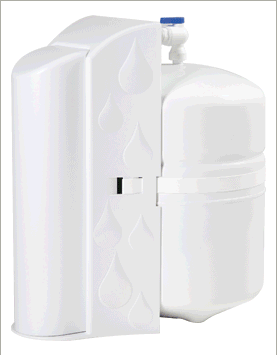
What We Recommend: Water Maker 5
The WaterMaker Five reverse osmosis machine quickly and easily generates high-quality drinking water. In a five-stage design, the system includes a 50-gpd reverse osmosis membrane and top-quality coconut carbon filtration. The WaterMaker Five RO system is designed with hygienically sealed filter cartridges and color-coded fittings for quick installation and easy service. It delivers 30% more flow from the faucet while reducing water waste by 50%.
Read More
Starting with the fact that it allows you more freedom, making you less dependent on how much water you can store; no matter how big the tank is, this is always limited, or in nearby ports where there may be long lines or supply restrictions. This means that you can choose your route more freely. Saves space and weight as compared to the water storage tank and or bottled water for a specific route, the water-maker takes up less space, and its weight is less than the sum of the water storage tank and the water storage. Smaller vessels generally benefit the most from this additional available space. With the energy recovery system produced by ecosystems, you do not need to invest in a generator. These devices also require minimal maintenance, which means you can recoup your investment right away because you can supply unlimited freshwater for free. When the water supply comes from a storage tank, it is usually necessary to calculate the amount of water required for primary demand; however, you can avoid the hassle of having to calculate water demand with a water maker. We suggest our valuable customers water maker five because of four main reasons. Firstly, it used 75% less water to drain, than most other RO systems. Secondly, because it’s a quick change filter, eleminates chances of contamination. Thirdly, it has a smaller footprint, fits nicely under counter. Lastly, it increases water output and production up to 50 gallons per day.
Benefits
- The Green-by-Design. WaterMaker Five uses a new membrane configuration to reduce water waste by 25%.
- Unique five-stage design utilizes water pressure more effectively resulting in 30% higher flow from the faucet.
- 50 gpd membrane refills the storage tank quickly, giving you more water when you need it.
- Compact design is smaller, lighter and saves under the counter space.
- Reverse osmosis membrane reduces total dissolved solids (TDS) by 96%.
- Top quality coconut carbon post-filtration provides final polishing for the freshest taste.
- Easy to install with pre-connected, color coded tubing and hygienically sealed filter cartridges.
- Easy to maintain. Replace the filter cartridges without tools.
- Manufactured in the USA.
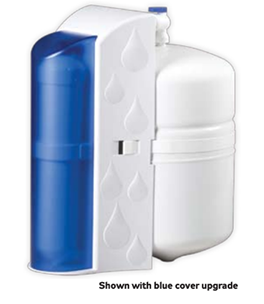
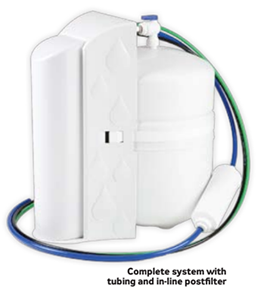
We take certification seriously.
Certiflow epitomizes a commitment to excellence in every facet of its operations. With an unwavering dedication to doing things right, the company places paramount importance on adherence to the law and industry standards. Certiflow meticulously follows regulations and protocols, ensuring that each product is manufactured with the highest quality and safety standards. The company recognizes the significance of proper certifications as a testament to its dedication to professionalism and reliability. By prioritizing ethical practices and regulatory compliance, Certiflow not only ensures the satisfaction of its customers but also contributes to the overall integrity and credibility of the plumbing industry.
Crafting Excellence with Certified Precision
In addition to its unwavering commitment to excellence in plumbing, Certiflow stands out with its extensive line of water softening devices, each meticulously crafted to meet stringent certification standards across all facets of their operation and creation. The company’s dedication to quality extends beyond mere compliance; it reflects a profound commitment to delivering products that not only adhere to industry regulations but also surpass customer expectations. From the selection of materials to the manufacturing processes, Certiflow ensures that every water softening device in its line undergoes rigorous testing and meets the highest industry standards for efficiency, durability, and environmental impact. This comprehensive approach not only underscores the company’s dedication to doing things right but also establishes Certiflow as a trusted leader in providing reliable and certified water softening solutions.
Building Better Business by bringing honesty back to water Treatment.
Building Better Business and Bringing Honesty Back to Water Treatment have been the guiding principles of Certiflow, for over 40 years. With a rich legacy of commitment to excellence, the company has seamlessly blended quality craftsmanship with a dedication to ethical practices. The team at Certiflow takes pride in its longstanding reputation for providing top-notch plumbing services and cutting-edge water treatment solutions, adhering to the core values encapsulated in these guiding mantras. As the company continues its journey, it remains steadfast in its mission to uphold integrity and reliability, making a positive impact on the industry it has served with distinction for more than four decades.
As Marlin Plumbing Service and Marlin Mechanical LLC. View our active listing by clicking here.
Soften your water at home, or in your business.
With certified water softening system that is guaranteed to provide iron free water.

